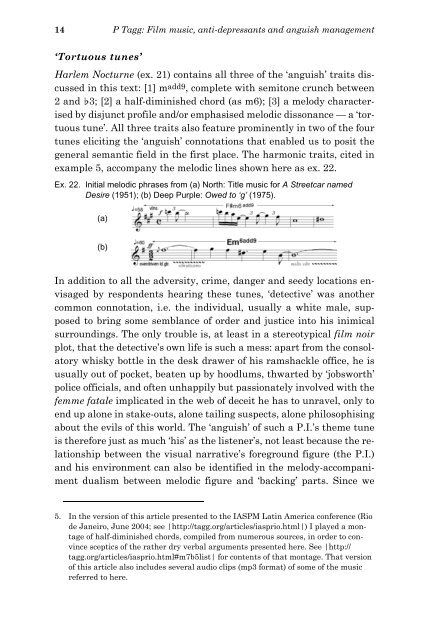Film music, antidepressants and anguish management - Philip Tagg
Film music, antidepressants and anguish management - Philip Tagg
Film music, antidepressants and anguish management - Philip Tagg
Create successful ePaper yourself
Turn your PDF publications into a flip-book with our unique Google optimized e-Paper software.
14 P <strong>Tagg</strong>: <strong>Film</strong> <strong>music</strong>, anti-depressants <strong>and</strong> <strong>anguish</strong> <strong>management</strong><br />
‘Tortuous tunes’<br />
Harlem Nocturne (ex. 21) contains all three of the ‘<strong>anguish</strong>’ traits discussed<br />
in this text: [1] madd9, complete with semitone crunch between<br />
2 <strong>and</strong> $3; [2] a half-diminished chord (as m6); [3] a melody characterised<br />
by disjunct profile <strong>and</strong>/or emphasised melodic dissonance — a ‘tortuous<br />
tune’. All three traits also feature prominently in two of the four<br />
tunes eliciting the ‘<strong>anguish</strong>’ connotations that enabled us to posit the<br />
general semantic field in the first place. The harmonic traits, cited in<br />
example 5, accompany the melodic lines shown here as ex. 22.<br />
Ex. 22. Initial melodic phrases from (a) North: Title <strong>music</strong> for A Streetcar named<br />
Desire (1951); (b) Deep Purple: Owed to ‘g’ (1975).<br />
(a)<br />
(b)<br />
In addition to all the adversity, crime, danger <strong>and</strong> seedy locations envisaged<br />
by respondents hearing these tunes, ‘detective’ was another<br />
common connotation, i.e. the individual, usually a white male, supposed<br />
to bring some semblance of order <strong>and</strong> justice into his inimical<br />
surroundings. The only trouble is, at least in a stereotypical film noir<br />
plot, that the detective’s own life is such a mess: apart from the consolatory<br />
whisky bottle in the desk drawer of his ramshackle office, he is<br />
usually out of pocket, beaten up by hoodlums, thwarted by ‘jobsworth’<br />
police officials, <strong>and</strong> often unhappily but passionately involved with the<br />
femme fatale implicated in the web of deceit he has to unravel, only to<br />
end up alone in stake-outs, alone tailing suspects, alone philosophising<br />
about the evils of this world. The ‘<strong>anguish</strong>’ of such a P.I.’s theme tune<br />
is therefore just as much ‘his’ as the listener’s, not least because the relationship<br />
between the visual narrative’s foreground figure (the P.I.)<br />
<strong>and</strong> his environment can also be identified in the melody-accompaniment<br />
dualism between melodic figure <strong>and</strong> ‘backing’ parts. Since we<br />
5. In the version of this article presented to the IASPM Latin America conference (Rio<br />
de Janeiro, June 2004; see |http://tagg.org/articles/iasprio.html|) I played a montage<br />
of half-diminished chords, compiled from numerous sources, in order to convince<br />
sceptics of the rather dry verbal arguments presented here. See |http://<br />
tagg.org/articles/iasprio.html#m7b5list| for contents of that montage. That version<br />
of this article also includes several audio clips (mp3 format) of some of the <strong>music</strong><br />
referred to here.














